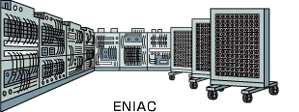|
|
 |
 |
| At the start of the 20th century, scientific technology began to advance rapidly. People now needed calculators that could very quickly and accurately handle difficult calculations with large numbers. Calculating atmospheric pressure and wind force, or even the speed and strength of airplanes made more advanced calculators very important. |
 |
|
In 1938, the German engineer Konrad Zuse created a calculator called Z1. This calculator was equipped with arithmetic and memory functions and was used to measure the strength of airplanes. His second model, Z2, used relays instead of gears for the arithmetic unit, but the memory component was still mechanical. In 1941, he successfully completed Z3, which was entirely powered by electricity. The Z3 also used relays for the calculation memory component (storage unit). The Z3 took the calculation results and used them automatically for more calculations (program control). Zuse was the first person to create a working machine based on the ideas of Babbage, the “Father of the Computer.” |
 |
| Around the same time, Harvard graduate student Howard Aiken, along with engineers from the U.S. Navy and IBM, succeeded in building a calculator that used 3,000 relays. It was called the Harvard Mark I. Although this device was completely automatic, it was still very slow in computing numbers and answers. The machine was HUGE! It was over 15 meters wide and 2.5 meters tall (49 feet, 2.5 inches wide, 8 feet, 2.4 inches tall), and weighed close to 5 tons. |
 |
 In 1946 in the U.S., John William Mauchly and J. Presper Eckert of the University of Pennsylvania developed a calculator called ENIAC (Electronic Numerical Integrator And Computer). Instead of relays, this calculator had 18,000 vacuum tubes. ENIAC was an enormous computer! It weighed 30 tons and was 2.5 meters high, 0.9 meters deep, and 24 meters wide (8 feet, 2.4 inches high, 2 feet, 11.4 inches deep, and 78 feet, 8.9 inches wide). It also used a lot of electricity (150 kilowatts of power). It worked amazingly fast, doing addition in only 0.8 milliseconds. It even performed time-consuming division in only 24 milliseconds. When ENIAC was first shown to the public, it correctly calculated 977,367 to the 5,000th power, astounding the many people who came to see it. In 1946 in the U.S., John William Mauchly and J. Presper Eckert of the University of Pennsylvania developed a calculator called ENIAC (Electronic Numerical Integrator And Computer). Instead of relays, this calculator had 18,000 vacuum tubes. ENIAC was an enormous computer! It weighed 30 tons and was 2.5 meters high, 0.9 meters deep, and 24 meters wide (8 feet, 2.4 inches high, 2 feet, 11.4 inches deep, and 78 feet, 8.9 inches wide). It also used a lot of electricity (150 kilowatts of power). It worked amazingly fast, doing addition in only 0.8 milliseconds. It even performed time-consuming division in only 24 milliseconds. When ENIAC was first shown to the public, it correctly calculated 977,367 to the 5,000th power, astounding the many people who came to see it. |
|
 |
| However, the wonderful calculators of Mauchly, Eckert and others were still inventions that could only be used by calculator researchers. In regular offices, most people were still using hand-cranked calculators, the mechanical devices that worked using gears. Later on, calculators with a small motor instead of a handle were introduced. They were slightly easier to use, but they were still very slow at calculating. Also, the noise and vibration they made were a problem. |
 |
|
 |
 |
|